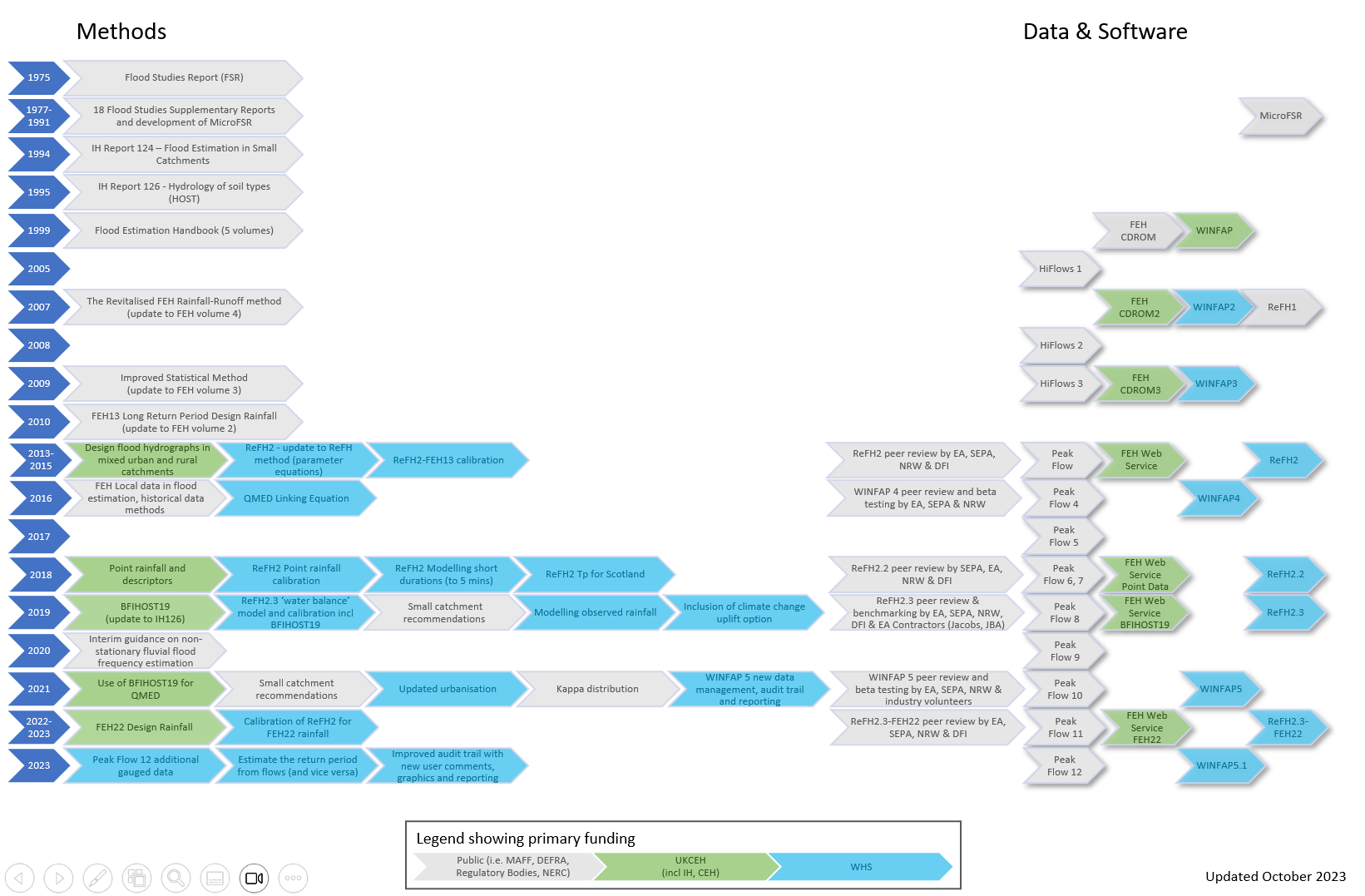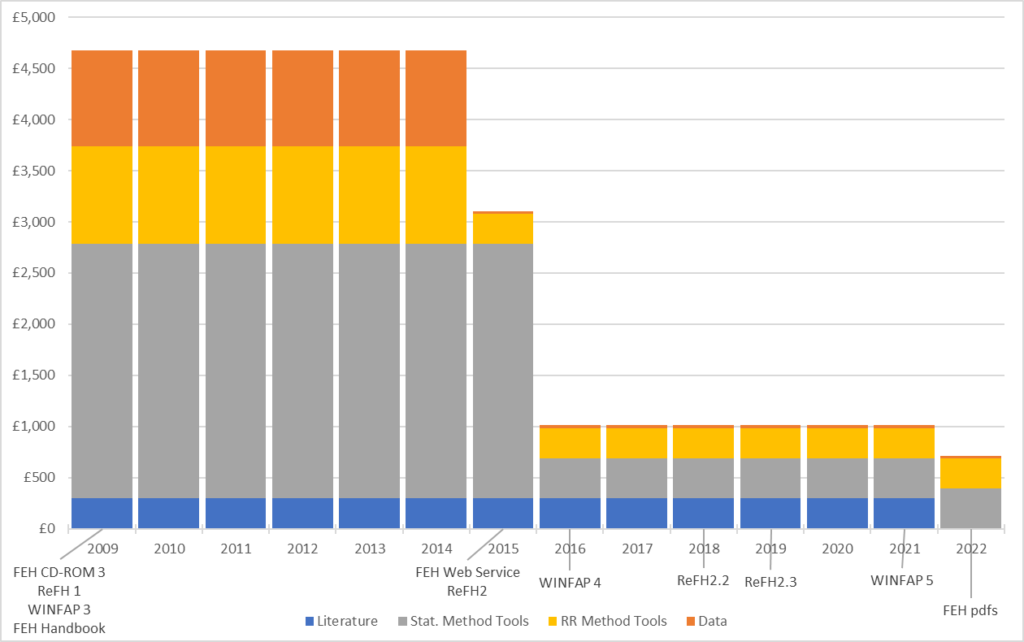History, present and future of the FEH
 |  |  | ||
| Find out more about the history of the FEH, including openness of FEH methods and how access to FEH has increased in recent years. | What our users think about current challenges and what they have told us about their software preferences. | Read our vision for the future of FEH methods. |
History of the FEH
A history of the major advancements in the flood estimation methods from the 1975 FSR to the latest FEH methods deployed in WINFAP 5 and ReFH 2.
The Flood Estimation Handbook (published in 1999) was publicly funded, as were the updates to Volume 4 (the Revitalised FEH Rainfall-Runoff method) in 2006-2007, Volume 3 (Improved Statistical Method) in 2008 and Volume 2 (FEH13 Long Return Period Design Rainfall) in 2010. Although there have been some publicly funded advancements (e.g. FEH Local, Small Catchments, Kappa Distribution), there has been a significant shift over the past decade to funding through reinvestment of income from the flood industry users of the data and software.
Openness of FEH Methods
All FEH methods that were developed using public funding are fully published. The current FEH methods have been peer reviewed by UK regulators and are published in our online technical guidance and supporting science reports. ‘Availability of FEH Methods‘ details the major advances in the FEH methods, how they were funded and how open each part of the method is.
The statistical method is fully published and therefore has always been open for anyone to write their own implementation: for example, the UKFE R package or in-house Excel applications.
The original ReFH1 model is fully published for implementation by anyone in the hydrological community (again, UKFE is an example of this). ReFH1 was developed for deriving flood estimates up to the 150 year return period using FEH99 (rather than FEH13 or FEH22) rainfall, and was found to perform poorly for high permeability catchments. Despite the known issues, there was no public funding available to further develop the methods and tools. WHS unilaterally invested in developing the published ReFH1 methods to improve and address gaps in the model, releasing ReFH2 in 2015, followed by the demonstrably improved ‘water balance’ ReFH2.3 model in 2019. The revised model and structure of equations are described in full in the ReFH2 technical guidance. The documentation describing the model and model results was extensively peer reviewed and benchmarked in 2019 by the EA, NRW, SEPA, DFI, and 2 EA framework contractors (Jacobs and JBA), and is published in the ReFH2 technical guidance and supporting science report. The subsequent calibration of the ReFH2.3 model using the FEH22 rainfall was peer reviewed by the EA, NRW, SEPA, DFI and UKCEH, with the science report published in 2023. The ReFH 2 parameter equations were derived using the dataset published in the FEH Supplementary Report 1 and extended by SEPA datasets for Scotland. The full parameter equation coefficients were incorporated for user information in the ReFH 2 in-software help in 2019. While the initial condition equation coefficients are commercially restricted, both the ReFH 2 model structure and gauged catchment dataset used for calibration (Peak Flow AMAX, catchment descriptors, and FEH13 rainfall) are open and freely available.
The FEH methods are therefore open for anyone to develop and improve. The WHS software is commercially developed, maintained and supported, at a cost that is passed on to its users. WHS have a proven track record of reinvesting to further the science and continuously develop user-focused software tools. We welcome collaboration across the hydrological community: please get in touch.
Increasing access to the FEH Methods
WHS was created by NERC as a spin-out company in 2004 with the specific aim of delivering cost-effective best practice science, to a wide range of users, in application focused tools. The minimal user subscription fees continue to fund advances in methods and the development and maintenance of tools for the flood hydrology community. Subscription fees for the EA, NRW and SEPA are waived for ReFH2 and significantly discounted for WINFAP. There are also significant discounts for educational users.
The flood risk industry practitioners fund the FEH methods by using the software and data in their commercial services. FEH methods are therefore sustainably funded with costs driven by use. This means that low volume users do not have a commercial disadvantage – a concern previously raised across the hydrological community. The chart illustrates the significant reduction in entry level costs around 2015-2016, when the FEH Web Service was developed by UKCEH to enable the purchase of single catchments, and WINFAP and ReFH2 moved from a one-off, high-cost purchase model to a low-cost annual subscription. The ongoing costs therefore now consist of a WHS WINFAP and ReFH2 annual software subscription and a UKCEH data cost linked to volume of use.
Current user requirements
Challenges

The 2022 FEH Methods User Survey included a question on the challenges users face conducting their assessments. 85% of responses were from users working in industry, 7% in regulation and 8% in academic research.
Around 75% of users find access to guidance describing ‘how the models work’ and ‘how you should apply the methods’ either not at all challenging or only slightly challenging.
In contrast, users find ‘keeping abreast of changes in legislation, policy and guidance’ and variations in ‘how the methods should be applied between countries’ more challenging.
Only 15% and 25% of users find the cost of FEH data and software challenging, whereas 56% find the cost of other related software (e.g. hydraulic modelling, drainage design) challenging.
Software preferences

We believe in making best practice methods easy to apply, so hydrologists can focus their time on making well informed decisions. The survey included a question on software preferences. The responses clearly show that practitioners want to use off-the-shelf commercial software packages, have access to technical support, and receive support on the application of the methods.
When asked about open source software, users are agreeable to such tools provided they are well maintained and supported. Those wanting to develop their own tools using open source libraries (e.g. Python or R) were in the minority. This is consistent with user satisfaction where over 80% of WINFAP and ReFH2 users are satisfied with ease of use, performance and reliability (90-98% when including those that are neither satisfied nor dissatisfied). No users reported dissatisfaction with the handling of their support queries.
Our vision for the future
As hydrologists, we believe:
- there should be more than one method,
- the effort and data required should be proportionate to the level of public risk associated with each study, and
- any method advancements need to be UK wide.
There needs to be a separation between science (collaboration for method advancement) and practice (pragmatism and clear guidance). Practitioners will continue to require methods that can be consistently applied, in reliable software, with appropriate guidance and support. There should be seamless integration with related tools. The vast majority of flood estimation and drainage design assessments are for low cost, low risk studies, so methods need to be quick and easy to apply. Additional detailed modelling is only warranted for the smaller number of high risk studies.
We believe advancing the UK flood estimation methods requires effective collaboration and communication; the FEH method developers and four UK regulators have made steady progress in these areas in recent years.
Research institutes, universities, regulators and industry now collaborate on method development, with regulators then reviewing and approving methods for use. WHS are currently working on joint research (including sharing some code sets) with academic institutes including UKCEH, University of Bath and University of Dundee to improve the FEH methods.
The four UK regulators, the main FEH method developers (UKCEH and WHS) and other researchers where appropriate now meet throughout the year. The NRFA Peak Flow Workshop on hydrometric data quality and significant method advancements is held annually. Additional FEH Joint Regulatory meetings are held quarterly. These provide an opportunity to review and discuss upcoming science and practitioners needs; bridging the gap between research and application. These meetings also aim to promote unity and commonality in how science is interpreted and used in practice in the four UK countries.
There are still many opportunities for improvement, but we believe the existing collaborative approach to FEH method development will be important in advancing UK flood hydrology and supporting the Flood Hydrology Road Map and EA Improvement Programme.
Please contact us if you would like to collaborate with us on FEH method development.

